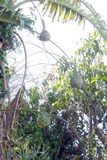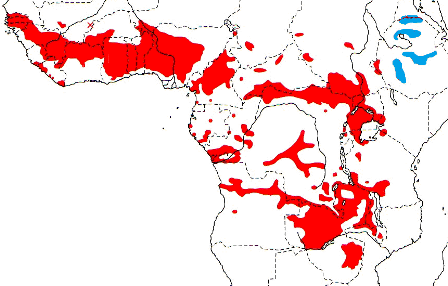Weaver species
Choose different species from drop-down list and press 'Go' button. See Full species list.Yellow-mantled Widowbird Euplectes macroura
IUCN: Least concern Discovery: 016Categories: long tail, pest, black and yellow bishops,
News items about species
Discovery

figure from Brown 1776 
figure from Daubenton 1783 
distribution, type locality circled IntroductionThe Yellow-mantled Widowbird was formally named by Johann Friedrich Gmelin, a German naturalist. Gmelin described many new bird species in a book in 1789 in the style of Linnaeus' publications, giving a brief description in Latin and a synonomy. Gmelin noted the locality for the Yellow-mantled Widowbird as "kingdom of Whidah, and to the river Senegal".There were, however, several authors who referred to the Yellow-mantled Widowbird before Gmelin, but not providing a scientific binomial name. The earliest reference is by Francois Salerne, a French naturalist who translated the ornithological work of John Ray, an English naturalist. Salerne added many details and some new species in the translation, including the first reference to the Yellow-mantled Widowbird, in 1767. Salerne named it Le Gros-bec noir (Black Grosbeak) and listed the origin of this species as "Kingdom of Judah in Africa, and sometimes in Senegal". This dual locality was copied by subsequent authors, but later restricted as Judah [Whydah] = Dahomey = Benin, probably because the range of the Yellow-mantled Widowbird in Senegal is far south of the Senegal River. Peter Brown, an English naturalist and illustrator, was the first to illustrate the Yellow-mantled Widowbird. He called it the Yellow shouldered Oriole and gave a description of the bird. He referred to Linnaeus (for the name Oriole) but did not provide a binomial name. Brown notes that his specimen was brought over from Holland by Thomas Pennant. Pennant travelled in Europe but not in Africa, so he would have obtained it from someone else. [note: in the species text, Brown misspelled Pennant as Tennant, but acknowledged Thomas Pennant in the Preface]. Statius Muller, who first described the Village Weaver, gave a Latin name for the Yellow-mantled Widowbird in 1776 but his name was invalid. Another colour illustration of the Yellow-mantled Widowbird is found in Daubenton 1783. Most likely a specimen of the Yellow-mantled Widowbird arrived in France from Benin together with other specimens, and was illustrated in the publications of Salerne and Daubenton but only formally described by Gmelin 13 years after the first illustration. Scientific citationLoxia macroura Gmelin 1789 Syst. Nat., 1(2):845 'in regno Whidah' = Benin.Meaning of namesmacroura (Greek): Makros, long; -ouros, tailed.First English nameYellow shouldered Oriole (Brown 1776).Alternate namesGold-backed Whydah, Yellow-mantled Whydah, Yellow-shouldered Whydah, Yellow-shouldered Whydah, Yellowshouldered Widow.CollectorUnknown.Date collectedBefore 1767.Locality collectedin the kingdom of Whidah, & to the river Senegal = Benin.Type specimensNo type specimens known to survive. |
The above is based on Weaver Wednesday 2, a weekly series about the discovery of each weaver species.
This species text first appeared as
Weaver Wednesday [133] - Discovery [16]: Yellow-mantled Widowbird on 2014-12-30
1. Basic biology
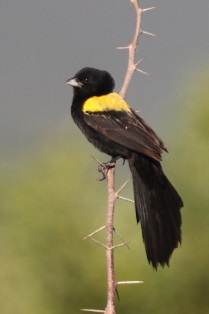
male, photographer Mike Buckham 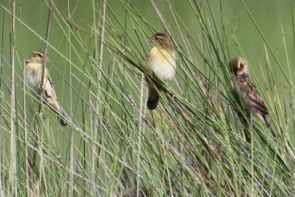
, figure cropped from Birdpix 7376
Identification. The Yellow-mantled Widowbird Euplectes macroura is widespread in African grasslands. The breeding male (photo right, by photographer Mike Buckham) is black with a yellow mantle and wing shoulder, and a long rounded tail. In Ethiopia, the yellow is only on the shoulder, but the similar yellow-shouldered subspecies of the White-winged Widowbird does not occur there. The Yellow Bishop male differs from the Yellow-mantled Widowbird in having a shorter tail, yellow rump and black mantle. The non-breeding Yellow-mantled Widowbird male has small yellow shoulder patches, and a longer tail than bishops in similar plumage. The female Yellow-mantled Widowbird does not have yellow shoulder patches but has yellow margins to the lesser and median coverts. Distribution.
Three subspecies of the Yellow-mantled Widowbird are recognised (see map below, based on Birds of Africa):
Habitat. The Yellow-mantled Widowbird inhabits moist grassland, and marshy areas with trees and scrub. It also occurs in rice fields and rank grass in abandoned farmlands. It roosts in reeds or papyrus in swamps, or in thickets. Food.
The Yellow-mantled Widowbird feeds mainly on seeds, especially of sedges, and also grass seeds. It also feeds on arthropods, including termites and their alates. The diet of adults is about 80% seeds and 20% arthropods. The Yellow-mantled Widowbird forages on the ground and in low vegetation, while termite alates are hawked in the air. It joins mixed-species flocks in the non-breeding season.
Breeding. The Yellow-mantled Widowbird is polygynous, with up to five females per male. It is territorial, but in areas of high density it appears to be colonial. The male pursues females in flight, with his tail depressed in display. Experiments showed that male tail length affects territory defence, but not the attractiveness of the male to females. The nest of the Yellow-mantled Widowbird is a large oval structure with a side entrance. The framework is woven into living grass blades by the male, and more successful mles build more nest frames. The female continues to add grass lining during incubation. The nest is placed 15-60 cm above the ground in grass, usually in damp areas. The 2-3 eggs are pale green, with heavy brown speckling. Incubation is by the female, and chicks are usually fed by the female. Nest failures are largely due to nests being trampled by grazing cattle or by grass-cutting. Old nests which may be taken over by Zebra Waxbills Amandava subflava. |
The above is based on Weaver Wednesday, a weekly series about weaver species.
This species text first appeared as
Weaver Wednesday [98]: Yellow-mantled Widowbird on 2014-04-30
2. Breeding facts
| Pair bond Polygynous, with up to five females per male Breeding season Sept-Nov in Sierra Leone and Liberia, Jun-Aug in Ghana, Jun-Nov in Benin, Aug-Sept in Burkina Faso, Jul-Oct in Nigeria and Niger, Sept-Nov in Cameroon, Oct in PRCongo; in DRCongo, Jul-Oct in NE and Jan-Apr in S; Aug-Oct in Sudan, Jul-Oct in Ethiopia, Jun-Aug in Uganda, May-Sept in Kenya, Jun in Tanzania, Mar-May in Angola, Dec-Mar in Zambia and Zimbabwe, and Jan-Feb in Malawi Nest site placed 15-60 cm above ground in grass less than 1 m tall, generally in damp or waterlogged area Nest building framework woven by male, female continues to add dry grass lining during incubation Colony size Territorial, but in areas of high density almost colonial Clutch size 2-3 eggs (average 2.6 in Zimbabwe) Egg colour pale green, heavily speckled with brown Egg size average size of 25 eggs 18.9 x 13.8 mm (Zimbabwe) Incubation incubation by female only, in captivity period 12-14 days Chicks and nestling period chicks usually fed by female only (wild male seen to feed once), nestling period 15 days |
Breeding information based on Handbook of the Birds of the World, Vol. 15.
3. Photos of Weaver Nests
 Vm 25265 | 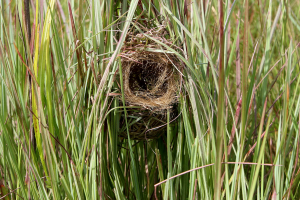 Vm 25264 | 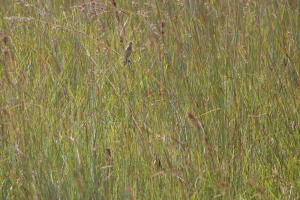 Vm 24324 | 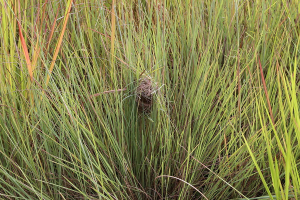 Vm 24323 |  Vm 24322 |  Vm 18780 |
Thumb-nails of most recent PHOWN records - click on one to see its full record
See all PHOWN records for this species here.
PHOWN (Photos of Weaver Nests) provides valuable info on breeding distribution and colony sizes of weavers.
You can contribute by registering and submitting photos at Virtual Museum webpage.
4. Breeding distribution
Google map showing distribution (For species with small ranges you need to zoom in at the correct area to see the range):
yellow blob - range of weaver species; read more about this here.
![]() - PHOWN records with photos
- PHOWN records with photos
![]() - PHOWN records with no photos (Nest Record Cards, other records)
- PHOWN records with no photos (Nest Record Cards, other records)
![]() - Birdpix records
- Birdpix records
![]() - comments on out of range records, or interesting records
- comments on out of range records, or interesting records
![]() - type locality
- type locality
CLICK on the marker on the map to see individual record details.
5. Range changes
Not South African speciesThe above is based on Weaver Wednesday 3, a weekly series about range changes in South African weaver species.
This species text first appeared as
n/a








